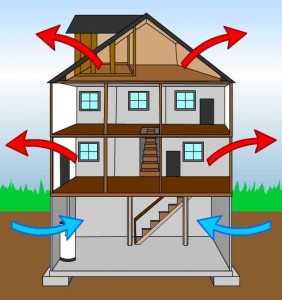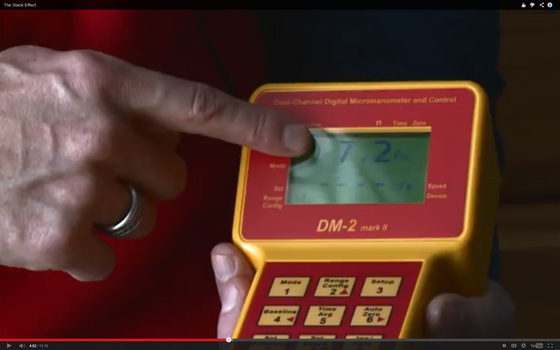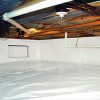
Stack Effect: High & low leakage. Warm air tends to leak out near the top of the house, causing outside air to leak into the house lower down.
The same convection force that makes a hot-air balloon rise can cause a house to have major comfort and energy problems.
Everyone knows that hot air rises and that cool air sinks. Convection: It’s a basic law of thermodynamics aptly demonstrated by a hot air balloon that ascends as it’s filled with heated air. When the air inside the balloon cools down and becomes denser, the balloon begins its journey back to earth.
Exfiltration + Infiltration = the Stack Effect
The connection between convection and home energy performance is known as the Stack Effect. In a house, this air movement phenomenon is most noticeable during cold winter months. Here’s how it works: Indoor air that’s been warmed by the heating system rises by convection to the upper areas of the house. Unfortunately, this warm air doesn’t stop moving when it gets to top floor’s ceiling. In a typical house, hundreds of gaps and cracks provide passageways for warm air to escape into the attic. Holes for recessed ceiling lights, gaps around a drop-down attic stairway and wall cavities used as electrical or plumbing chases are common leak locations. Interior air that leaks out of the house is called “exfiltration.”
Losing the air you’ve paid to heat is bad enough, but this escaping air creates negative pressure inside the house –a vacuum that causes air infiltration. Cold outside air is sucked into your living space through other cracks, gaps and openings. In the winter, cold air infiltration usually occurs in lower parts of the house –like the basement and/or crawl space. But air infiltration can also occur around window and door framing and around electrical outlets located in exterior walls.
Is the stack effect at work in your house? Check for these signs.
Symptoms of the Stack Effect at work in your house include cold drafts you can feel near exterior walls (especially around electrical outlets and window trim) and cold drafts in the basement. You may also notice that the floor surface directly above a basement or crawl space is uncomfortably cold during winter months. Up in the attic, evidence of air leakage and Stack Effect energy loss can often be found on the fiberglass insulation installed over the attic floor. Insulation installed near an air leak will often discolor from the dust deposited on the fine fibers by rising air.
The comfort problems caused by the Stack Effect also cause energy problems. With heated air leaving the house and cold air entering, your heating system has to work longer and harder to maintain comfortable interior temperatures. Dan Morrison, a former contractor who now works as the editor of Builder magazine, explains why the Stack Effect imposes such a high energy penalty on a “leaky” home : “During cold weather when the Stack Effect is strongest, heated air is constantly escaping, and it’s being replaced by an equal volume of cold outside air. Because the cycle continues 24/7, you’re going to be spending a lot of money to keep warm.”
Sealing air leaks short-circuits the Stack Effect.
The Stack Effect has three “drivers” that determine its magnitude: the overall height of your total living space (multi-story buildings tend to have stronger convection), the interior-exterior temperature difference (the larger the difference, the stronger the effect) and the amount of air leakage in the house. Since you can’t do anything about the first two drivers, it’s necessary to focus on the third: air leaks. Having your home professionally air sealed will effectively short-circuit the Stack Effect by dramatically reducing air exfiltration and infiltration. It’s especially important to seal attic air leaks, since this is where most warm air escapes in the winter. According to Dept. of Energy research, attic air sealing, when combined with an attic insulation upgrade, can cut your heating and cooling costs nearly in half.






My mother in law recently had foam insulation sprayed between floor joists. A few months later she had insulation blown into her attic. She has replaced windows and put new caulking around all windows. The problem she is facing is the appearance of cracks in all interior corners of the house as well as bowing of some walls and floors. This is a 40 year old brick home with no previous issues. What the heck is going on?
The insulation upgrades you mention will definitely change how the house performs. If the house has been made significantly tighter (a strong probability), with no modifications to improve ventilation, it’s possible that there might be an issue with excess moisture indoors. But whether this has something to do with the bowed walls and floors is uncertain. I recommend calling in the contractor(s) who installed the insulation and seeing what they have to say.
Could she be experiencing truss lift? This can happen when the bottom of the trusses are warm and moist (due to being covered with insulation), and the top part of the trusses are cold and dry. It can make the trusses bow, which can lift up the ceilings underneath them.
Truss uplift could be a possibility, but it’s more likely for a 40-year-old brick house to have a framed roof structure. I still think it’s more important to investigate ventilation and moisture issues.
I moved into my current house in 2013. During the winter it would get cold inside like most other houses, but the master bedroom was the coldest. I had thought it was all due to factors other than the attic above the two bedrooms, and simply threw more wood into the stove. This last spring I decided I wanted to be able to use the attic above the bedrooms for storage. It had a bunch of trampled loose fill fiberglass, so I removed it all and methodically replaced it with two R-15 layers of Roxul carefully placing it everywhere I could. I ran the top layer perpendicular to the one below, and a third layer of smaller pieces above the recessed cans.
This, combined with a radiant barrier seemed to make a significant difference over the summer but the real test was the two cold spells we had here recently (single digits overnight). I routinely use my wood stove in the winter and throw on a log before I go to bed. The bedtime temp is usually in the mid to upper 70’s, and if it’s really cold out the furnace might kick on when it gets to 60 inside.
In the last week or so, I’ve noticed the inside temp only a few degrees cooler in the morning than at bedtime. I’ve also noticed the basement is no longer an ice box like it felt before. Most importantly, my bedroom is now the same temp as the rest of the house – I now understand and respect the stack effect!
When I bought my HVAC system in 2017, the new thermostat had a circulation fan on choice. I mostly put it on Automatic but in the winter, the circulation mode comes on also between heating cycles. What this does is pull the heated air from the ceiling and recirculates it through the vents. Have not used long enough to determine if it saves money or not.